Orthodontics/Braces at Any Age – Victoria Dentists
People of any age can benefit from orthodontic treatment. Teeth that are crooked, crowded or that stick out affect the way your teeth look and work. Orthodontic treatment not only improves the look of your smile but your health as well. Straight teeth are easier to clean and less likely to get tooth decay or injured. If you are not happy with the way your teeth look or work, orthodontic treatment may help.
What is Orthodontic Treatment?
Orthodontic treatment straightens your teeth so they look and work better. Braces or other appliances are used to put gentle pressure on your teeth. Over a number of months or years, this pressure can move your teeth into the right position.
Why You May Need Orthodontics
The position of your teeth and jaws has an effect on your bite. Your bite is how your top and bottom teeth come together. When your top and bottom teeth do not fit together properly, this is called a malocclusion or a bad bite. Problems like missing, crooked, crowded or protruding teeth can contribute to a bad bite. Thumb or finger-sucking may also affect your bite.
A bad bite can make it hard to chew some foods and may cause some teeth to wear down. It can also cause muscle tension and pain. Teeth that stick out are more easily chipped or broken. Crowded and crooked teeth are harder to clean and may be more likely to get cavities and gum disease. Fixing a bad bite improves your smile and your health. Different types of bad bites include an overbite, a crossbite, an overjet and an open bite.
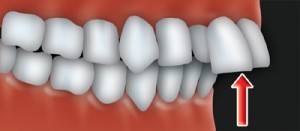
An overjet occurs when the upper front teeth protrude.
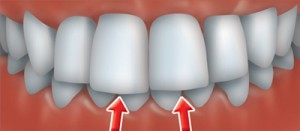
A deep bite occurs when the upper front teeth cover the lower front teeth too much.
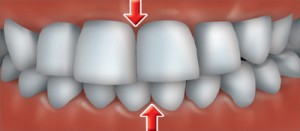
A crossbite occurs when one or more of your upper teeth don’t line up with the appropriate lower tooth or teeth .
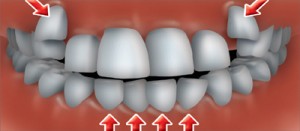
Crowded or overlapped teeth.
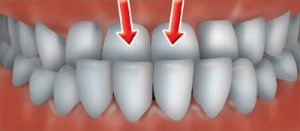
An underbite occurs when the upper teeth fit inside the arch of the lower teeth.
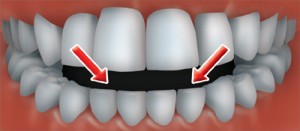
An open bite occurs when the back teeth are together and there is an opening between the lower and upper front teeth.
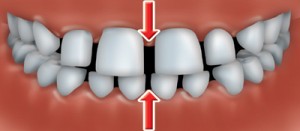
Gaps between teeth
Who Does This Procedure?
Your dentist may do basic orthodontic treatment or refer you to an orthodontist. An orthodontist is a dentist who has completed a university post-graduate specialty program in orthodontics. Orthodontics is a specialty of dentistry that deals with preventing and correcting malocclusions.
Who Can Get Orthodontic Treatment?
Orthodontic treatment isn’t just for teens, as teeth can be moved at any age. In fact, more and more adults are having orthodontic treatment to improve the look and health of their smile. Your dentist or orthodontist can evaluate if orthodontic treatment is right for you.
In some cases it is helpful to start orthodontic treatment before all the permanent (adult) teeth come in. This is called interceptive orthodontics. Your dentist or orthodontist can do an orthodontic screening to find out if your child will need orthodontic treatment to correct a bad bite. Interceptive orthodontics allows your dentist or orthodontist to treat or stop a problem as it is developing.
How Long Does the Treatment Take?
Orthodontic treatment takes time. The amount of time depends on your age, the seriousness of your problem and the treatment technique used. Treatment generally involves a visit to your dentist or orthodontist on a regular basis over a period of months to years. In general, it takes longer to treat adults than children or teenagers. Most people wear braces for about 2 years.
Orthodontic Treatments
Depending on the extent of your bad bite, your dentist or orthodontist may suggest one or a combination of the following orthodontic treatments to correct your bite:
- Braces.
- Headgear.
- Removable appliances.
- Retainers.
- Oral surgery.
Braces
The most common type of orthodontic treatment used by dentists or orthodontists is braces.
How Braces are Done
To apply braces, your dentist or orthodontist attaches brackets (or bands) to each tooth with glue. Arch wires are fitted into all the brackets and are usually held in place with rubber or wire ties.

You may feel some discomfort for a while when your braces are first put on and when they are adjusted. It will take a little time to get used to your braces and they can bother your lips and cheeks. If this happens, a relief wax can be applied to your braces. To make eating easier after an adjustment, soft foods are recommended.
Caring for Your Teeth With Braces
Proper brushing and flossing is even more important for people with braces because plaque can easily build up around the edges of your braces. If this plaque is not properly removed, white or brown marks may appear on the enamel surface of your teeth and these marks may be permanent.
Brushing and flossing with braces take longer. It is important to brush your braces as well as the front, back and chewing surfaces of the teeth. Your dentist or orthodontist will give you tips on how to brush and on how to floss using floss threaders. Parents should supervise their children to make sure they do a good job cleaning their teeth and braces and follow the advice of their dentist or orthodontist.
Caring For Your Braces
If you have braces, do not bite on hard things such as ice cubes and nuts. Do not chew the ends of pens or pencils. Also avoid sticky treats like chewing gum or toffee because they can loosen braces, distort wires and even pull braces off your teeth. If any of these problems happen, you will need to have your braces repaired by your dentist or orthodontist.
If the elastics or ties come off the bracket, you may be able to put them back around the bracket using small tweezers. If a wire is sticking out and bothering your lip or cheek, you may be able to push it back into place with the rubber eraser end of a pencil or it may be carefully cut off with a nail clipper. When a problem happens, always contact your dentist or orthodontist to have your braces checked as soon as possible. Problems that are not fixed can cause the treatment to last longer.
Choices in Braces
Today’s braces are smaller and less noticeable. Besides the traditional metal braces, there are tooth-coloured ceramic braces that are less noticeable. Clear aligners are also available for adults. Braces and elastics can also be multicoloured. Speak to your dentist or orthodontist about all your choices.
Headgear
This treatment uses an appliance that fits around the head or neck. It guides the direction of tooth movement and jaw growth in someone who is still growing. There are different types of headgear and they may be worn during any part of the orthodontic treatment. Your orthodontist or dentist will show you how to put on the headgear and tell you how long to wear it each day. In most cases it is worn during the evening and at night.
Removable appliances
Although removable appliances are not as precise as braces, they can move a tooth or a group of teeth. They are fitted by your dentist or orthodontist. Removable appliances can be worn before braces are applied, while braces are worn, or on their own to treat specific problems.
Retainers
Once your braces have been removed, a retainer can be used to keep your teeth in the right place. Retainers are fixed (attached to the teeth) or removable. They may need to be worn all the time or part of the time.
Oral Surgery
Tooth removal may be needed if your teeth are crowded or if a tooth is badly out of position. Jaw surgery (or orthognathic surgery) may be needed when there are major differences in the size or position of the upper and lower jaws. If your orthodontist thinks you will need jaw surgery, he or she will refer you to an oral and maxillofacial surgeon.
